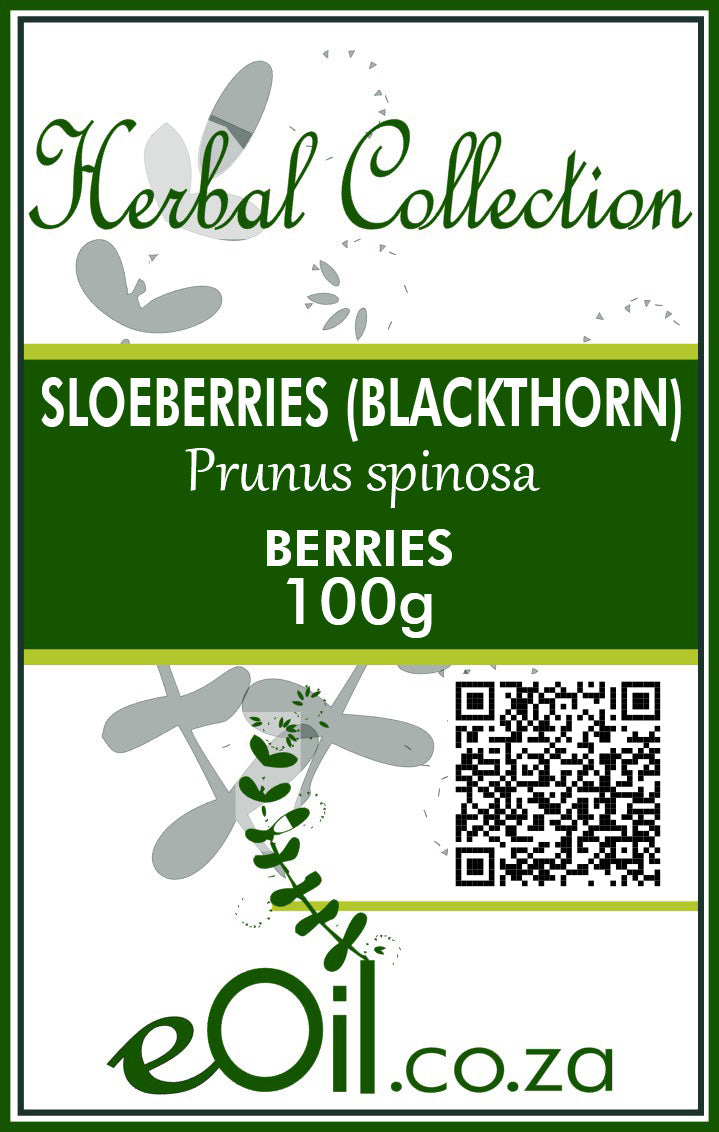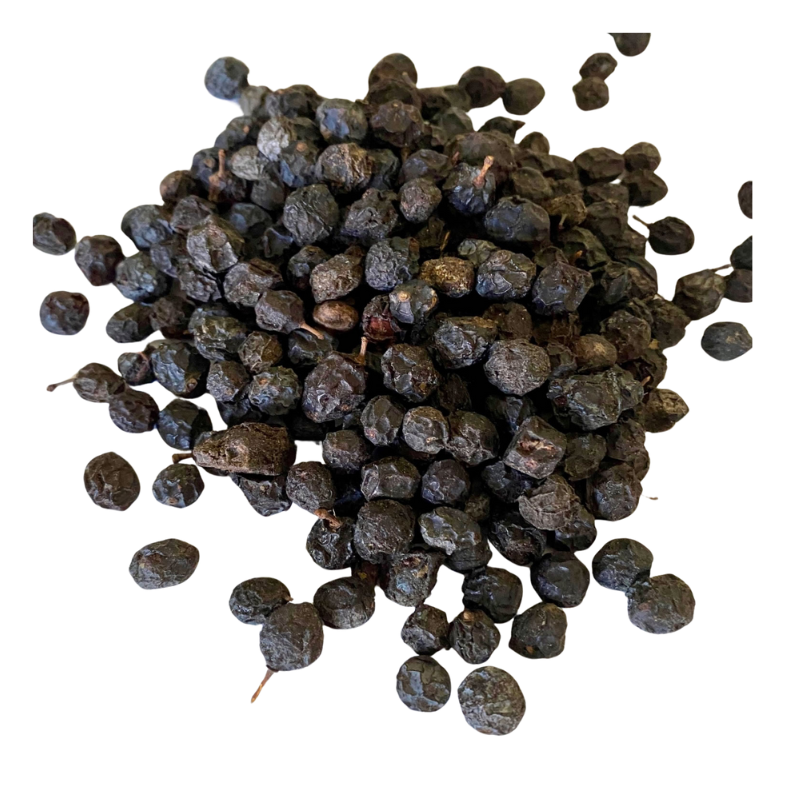Blackthorn Sloeberries Dried Berries - Herbal Collection
Blackthorn Sloeberries Dried Berries - Herbal Collection - 100 GR is backordered and will ship as soon as it is back in stock.
Description
Description
Blackthorn Sloeberries Dried Berries (Prunus spinosa) are wild-harvested, sun-dried berries with a tart, intensely plum-like flavor.
Traditionally used in sloe gin, cordials, teas, and preserves, they offer natural antioxidants, flavonoids, and vitamin C.
Ideal for culinary recipes, herbal infusions, and artisanal beverages—pure and additive-free
TRADITIONALLY USED FOR
Blackthorn (Prunus spinosa), also known as sloe, is a small deciduous tree native to Europe, western Asia, and parts of North Africa. The tree produces small, dark purple fruit called sloeberries.
These berries have been traditionally used for various purposes, and they are usually harvested after the first frost to make them less astringent.
Some of the potential benefits, properties, and traditional uses of dried sloeberries include:
- Antioxidant properties: Sloeberries are rich in antioxidants, such as anthocyanins and flavonoids, which help protect the body from free radicals and oxidative stress. Antioxidants may contribute to a reduced risk of chronic diseases, such as heart disease and certain types of cancer.
- Anti-inflammatory properties: The phenolic compounds in sloeberries may have anti-inflammatory effects, which can help to reduce inflammation in the body.
- Digestive health: Traditionally, sloeberries have been used to treat gastrointestinal issues such as constipation and diarrhea due to their astringent properties.
- Immune support: The vitamin C content in sloeberries can help support the immune system and contribute to overall health.
- Heart health: The potassium content in sloeberries may help to maintain healthy blood pressure levels and support overall cardiovascular health.
- Skincare: Due to their astringent properties, sloeberries have been used in traditional skincare remedies to help tighten and tone the skin, as well as to reduce inflammation and redness.
- Traditional beverages: Dried sloeberries are often used to make sloe gin, a popular British liqueur, as well as other traditional beverages such as cordials and syrups.
MORE INFORMATION
Source : http://www.wikiphyto.org/wiki/Prunellier
Reference on http://www.wikiphyto.org
Translation in English by Google Translate (go to the page of the source linked | on Chrome cellphones go on the 3 dots on the top right and select translate in your preferred language | on laptop right click your mouse and select option translate when hoovering on the page
plant name
Blackthorn , Blackthorn (English)
International Latin denomination
botanical family
Rosaceae
Description and habitat
- Shrub about 4 m high, with thorny, brown-black branches, type 5 white flowers, appearing before the stalked, oval leaves with finely toothed edges
- Fruits (drupes) with a sour and astringent flavor, spherical, blue-black in color
History and tradition
Parts used
- Flowers, fruit
Dosage forms available
- Mother tincture of young twig with flower buds
Usual dosages
Composition
Main components of the plant
- Flowers:
- Flavonoids : quercetol ( quercetin ) and kaempferol glycosides , quercitroside , rutoside , hyperoside kaempferol 3-O-alpha-L-arabinofuranoside , quercetin 3-O-alpha-L-arabinofuranoside , kaempferol 3-O-alpha-L-ramnopyranoside , kaempferol 7-O-alpha-L-ramnopyranoside , kaempferol 3-O-beta-D-xylopyranoside , kaempferol 3-O-(2''-Ep-coumaroyl)-alpha-L-arabinofuranoside [1]
- Cyanogenic glycosides (fresh flower)
- Coumarins (?)
- fruit:
Main components of buds or young shoots
Main components of essential oil
Properties
Plant properties
- Mild laxative, diuretic, diaphoretic, expectorant
- Homeopathy: tonicardiac, headaches
- The fruit is astringent in affections of the oral cavity
- The fruit is antioxidant [3] , like the flower [4] , [5]
- Anti-cancer activity [6]
Bud properties
Properties of essential oil
Directions
Indications of the whole plant (phytotherapy)
- Digestive and bronchial disorders
- Fruit: affections of the oral cavity
- Homeopathy: Facial neuralgia and facial pain due to ophthalmic shingles
- Anthroposophy: states of exhaustion, anemia, hypotension, convalescence, flu prophylaxis
Indications of the bud (gemmotherapy)
Specific indications of essential oil (aromatherapy)
Known or suspected mode of action
Usual formulations
Regulations
- Activity recognized by the German Commission E
Possible side effects and precautions for use
Bibliographic references
- Aller↑ Olszewska M, Wolbiś M. Flavonoids from the flowers of Prunus spinosa L. Acta Pol Pharm. 2001 Sep-Oct;58(5):367-72. PMID 11876444
- Aller↑ Herbert Kolodziej, Mahmut K. Sakar, Johann FW Burger, Rolf Engelshowe, Daneel Ferreira. A-type proanthocyanidins from Prunus spinosa. Phytochemistry, Volume 30, Issue 6, 1991, Pages 2041-2047 https://doi.org/10.1016/0031-9422(91)85064-7
- Aller↑ Jasmina M. Veličković, Danijela A. Kostić, Gordana S. Stojanović, Snežana S. Mitić, Milan N. Mitić, Saša S. Ranđelović, Aleksandra S. Đorđević. Phenolic composition, antioxidant and antimicrobial activity of the extracts from Prunus spinosa L. fruit. Um. ind. 68 (3) 297–303 (2014) doi:10.2298/HEMIND130312054V
- Aller↑ Marchelak Anna, Owczarek Aleksandra, Matczak Magdalena, Pawlak Adam, Kolodziejczyk-Czepas Joanna, Nowak Pawel, Olszewska Monika A. Bioactivity Potential of Prunus spinosa L. Flower Extracts: Phytochemical Profiling, Cellular Safety, Pro-inflammatory Enzymes Inhibition and Protective Effects Against Oxidative Stress In Vitro. Frontiers in Pharmacology (8) 2017. DOI=10.3389/fphar.2017.00680
- Aller↑ Raquel Pinacho, Rita Yolanda Cavero, Icíar Astiasarán, Diana Ansorena, María Isabel Calvo. Phenolic compounds of blackthorn (Prunus spinosa L.) and influence of in vitro digestion on their antioxidant capacity. Journal of Functional Foods, Volume 19, Part A, December 2015, Pages 49-62 https://doi.org/10.1016/j.jff.2015.09.015
- Aller↑ Meschini S, Pellegrini E, Condello M, Occhionero G, Delfine S, Condello G, Mastrodonato F. Cytotoxic and Apoptotic Activities of Prunus spinosa Trigno Ecotype Extract on Human Cancer Cells. Molecules. 2017 Sep 20;22(9). pii: E1578. doi: 10.3390/molecules22091578. PMID 28930188
CAUTION
Store in a cool, dry place, away from light. Keep tightly closed, away from the reach of Children and pets.
Do not exceed the daily dose.
This product is not intended to prevent or cure any form of illness or disease.
If you are pregnant or nursing ; If you have a medical condition or are in the course of medical treatment ; If you are programmed for theater/operation in the near future, please consult your healthcare practitioner before using this product.
This product cannot replace a varied and balanced diet and a healthy lifestyle.
This product has not been evaluated by the SAHPRA for its quality, safety or intended use.
For More Information please check our General Safety Herbal products Page






